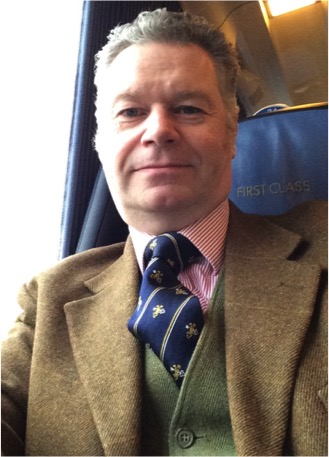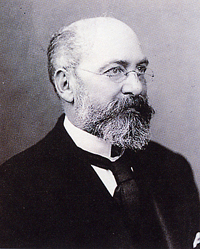
Welcome from Mr Jonathan Goddard
Curator of the BAUS Virtual Museum
"... virtual again, but back in Liverpool historically ..."
Well, here we are again, a second virtual BAUS! We would have been in Liverpool this year and I’m sure we will all miss walking to the conference through the historic docks and seeing the Liver Building towering above. However, our Museum of Urology on the BAUS website has always been virtual, so we’re in a great position to keep you up to speed with the latest in the history of urology!
The History of Urology poster session
Once again, we have had a fantastic submission of history abstracts, both in number and quality. The session looks like it’s going to be a fascinating chance to delve into multiple and diverse areas of urology past; well worth attending. Certainly, last year’s virtual session was the most well attended ever and the enhanced digital posters added a great personal aspect to the projects, revealing the passion and hard work that goes into researching the topics.
The Museum stand
 Although I will not be able to build an exhibition of artefacts for you to examine over your coffee, and I will miss chatting to you all face to face, I encourage you to visit us in the Museum of Urology. We are constantly updating the content, so there will always be something new. Remember, we have built a new upper floor to house the new Members’ Art Gallery. This is an amazing insight into the wonderful artistic talents of some of our members, and a reminder of that close link between art and medicine.
Although I will not be able to build an exhibition of artefacts for you to examine over your coffee, and I will miss chatting to you all face to face, I encourage you to visit us in the Museum of Urology. We are constantly updating the content, so there will always be something new. Remember, we have built a new upper floor to house the new Members’ Art Gallery. This is an amazing insight into the wonderful artistic talents of some of our members, and a reminder of that close link between art and medicine.
I hope you will submit an image to the Photography Competition, which will be judged at the Annual Meeting. The winner will receive some Apple airpods, so get "clicking" and good luck!
Liverpool - where we would have been
 There is a lot of urological history in Liverpool. One of the great seaports of the British Empire, Liverpool was a busy city in the 19th century and saw the comings and goings, not only of goods, but also sailors and, in particular, the injuries and diseases that sailors attract. This accumulation of imported disease led to the establishment of specialists to treat them. Reginald Harrison (1837 – 1908) and Hugh Owen Thomas (1834 – 1891) are two famous doctors that emerged from this concentration of nautical ailments, one name you may recall from the history of urology, but the other, although you may know him from the history of orthopaedics, also has a link to our urological history.
There is a lot of urological history in Liverpool. One of the great seaports of the British Empire, Liverpool was a busy city in the 19th century and saw the comings and goings, not only of goods, but also sailors and, in particular, the injuries and diseases that sailors attract. This accumulation of imported disease led to the establishment of specialists to treat them. Reginald Harrison (1837 – 1908) and Hugh Owen Thomas (1834 – 1891) are two famous doctors that emerged from this concentration of nautical ailments, one name you may recall from the history of urology, but the other, although you may know him from the history of orthopaedics, also has a link to our urological history.
Reginald Harrison (pictured right) was a well-known urological surgeon working at the famous St Peter’s Hospital in London but, before moving there, he ran a busy private and hospital practice in Liverpool. The sailors of the Liverpool docks furnished Harrison with plenty of urethral strictures to manage (remember that these were primarily caused by gonorrhoeal infection). After travelling to America to watch Bigelow perform his new litholapaxy operation, he brought that back to Britain. He was also an early advocate of removing pieces of obstructing prostate found at the time of open lithotomy.
When BAUS held its annual meeting in Liverpool in 2016, the Journal of Clinical Urology kindly allowed me to write an article about Harrison in the abstract book. You can read this in the Museum of Urology Library here.
Hugh Owen Thomas is famous in the history of orthopaedics. He invented the Thomas split, initially to treat tuberculous knee infection. In the First World War, its use to immobilise femoral fractures led to a dramatic fall in mortality and a reduction in the number of lower limb amputations. The Liverpool sailors also presented him with many old and badly healed fractures sustained on the long sea voyages, and the cramped and poor conditions of the Liverpool docks provided plenty of TB patients. I was surprised - and excited - to find out recently that Thomas also operated on bladder stones. In 1890, he published on lithotomy, reviewing the known techniques and describing a combination of his own which he felt was much better.
 More history at BAUS 2021
More history at BAUS 2021
This year at BAUS 2021, we are collaborating with Karl Storz Endoscopy (UK) Ltd - always a great supporter of history and the Museum - to present aspects of the history of urology and some historic instruments in a virtual presentation.
Don’t forget to keep up with the History Column in Urology News which links with topics in the Museum of Urology. Urology News generously allows back issues of the column to be displayed in the Museum library.
Finally, keep in touch with the Museum of Urology, and keep yourself up to date with the latest in urological history by following us on Twitter (@urology_history) (and use the hashtag #BAUS21).
See you at BAUS!